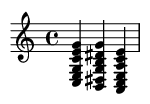Summary:
The augmented chord, built by stacking two major thirds, is a perfectly symmetrical harmony that divides the octave into three equal parts. Its unique structure creates a sense of tension, mystery, and instability, making it a powerful tool for composers to add chromatic color, facilitate smooth modulations, and create powerful emotional effects.
Keywords:
Augmented chord, augmented triad, major thirds, symmetrical harmony, raised fifth, sharp five, V+ chord, modulation, chromatic harmony, whole-tone scale, altered dominant.
What is an Augmented Chord?
In the world of harmony, major and minor chords feel stable and grounded. The augmented chord is their restless cousin. It possesses a floating, unresolved quality that can feel mysterious, dreamy, or intensely dramatic. Unlike stable chords that provide a sense of arrival, the augmented chord creates anticipation, pushing the music forward and demanding resolution.
This unique character comes from its perfectly symmetrical construction. It’s a triad built entirely of major thirds. This symmetry means it has no clear tonal center on its own, allowing it to act as a chameleon in music, shifting its function depending on the context.
Structure and Construction
An augmented triad is built using a simple, repeating formula of intervals. It consists of:
- Root: The starting note of the chord.
- Major Third: An interval of 4 semitones above the root.
- Augmented Fifth: An interval of 8 semitones above the root (or 4 semitones above the Major Third).
Essentially, you stack two major thirds on top of each other. This raised fifth (also called a sharp five or #5) is what gives the chord its name and its tense, unstable sound.
Chord Notations:
A C augmented chord can be written in several ways: Caug, C+, or C(#5).
Example: C Augmented Chord
The notes are C (Root), E (Major Third), and G# (Augmented Fifth).
The Magic of Symmetry
The most remarkable feature of the augmented chord is its perfect symmetry. Each note is a major third (4 semitones) away from the next. This has two profound consequences:
- No True Inversions: If you invert an augmented chord, you get another augmented chord. For example, the notes of C+ are C, E, G#. If you invert it to start on E, the notes are E, G#, C. This is an E augmented chord (E+). Start on G#, and you get a G# augmented chord (G#+). They all contain the exact same pitches.
- Only Four Unique Chords: Because of this enharmonic equivalence, there are only four distinct augmented chords in all of music. Every other augmented chord is simply an inversion (or a different spelling) of one of these four.
The Four Unique Augmented Chords
This example shows how C+, E+, and G#+ are all made of the same three notes.
Harmonic Function and Resolution
The augmented chord's power lies in its instability. The augmented fifth feels like it needs to go somewhere. This strong pull is the key to its function.
The most common tendency is for the augmented fifth to resolve upward by a half step. This outward expansion creates a satisfying release of tension.
1. As a Chromatically Altered Tonic (I+)
A very common use is to alter a major tonic chord (I) to create momentum toward the subdominant chord (IV). The raised 5th of the I+ chord resolves smoothly upward into the 3rd of the IV chord.
Example Progression: C → C+ → F (I → I+ → IV)
Listen for the chromatic line G → G# → A in the top voice. This creates a powerful and smooth connection between the C and F chords.

2. As an Altered Dominant (V+)
In both classical and jazz, the augmented chord frequently appears as an altered dominant (V+). Here, the fifth of the dominant chord is raised to create even more tension pulling towards the tonic. For example, in the key of C, the dominant chord is G major (G-B-D). A G augmented chord (G-B-D#) creates a powerful pull to C major, as the D# resolves upward to E (the third of the tonic).
Example Progression: C → G+/B → Am
This example shows G+ in first inversion (G+/B) acting as a passing chord between C and Am. Notice the smooth, chromatic voice leading in every part: C→B→A, E→D#→E, G→G→A.

The Whole-Tone Connection
The augmented chord is intrinsically linked to the whole-tone scale, a six-note scale made up entirely of whole steps (e.g., C-D-E-F#-G#-A#) . Stacking two major thirds (C-E-G#) gives you half of a whole-tone scale. Because the scale itself has no half-steps, it lacks the leading tones that define a key, resulting in the same floating, ambiguous quality as the augmented chord.
Composers like Claude Debussy used the whole-tone scale and its inherent augmented harmonies to create the signature sound of Impressionism—shimmering, dreamlike, and detached from traditional harmonic rules.
Usage Across Genres
- Classical Music: Late Romantic composers like Wagner and Liszt used augmented chords for intense drama and to modulate to distant keys. Impressionists like Debussy and Ravel used them for color and atmosphere.
- Jazz: The augmented sound is a cornerstone of jazz harmony, most often found in altered dominant chords (e.g., G7#5) to create sophisticated tension before resolving to the tonic.
- Film Music: It's a go-to tool for scoring. Composers use it to create suspense, signal a dream sequence or flashback, or evoke a sense of magic and wonder. Think of the opening fanfare of the original Star Trek theme.
- Pop & Rock: While less common, it appears for dramatic effect. The Beatles' "Oh! Darling" uses a I+ chord (A+) in the verse for a powerful emotional plea. The opening of "Maria" from West Side Story famously outlines an augmented chord.
Extended Augmented Harmonies
The augmented triad can be extended, most commonly in two ways:
- Augmented Major Seventh (aug(maj7)): An augmented triad with a major seventh (e.g., C-E-G#-B). This chord has a very dreamy, complex sound, often associated with the Lydian Augmented scale.
- Dominant Seventh Sharp Five (7#5): An augmented triad with a minor seventh (e.g., G-B-D#-F). This is the V+ chord mentioned earlier and is a staple of jazz harmony, functioning as a tense dominant chord that resolves strongly to the tonic.
Common Mistakes to Avoid
- Overuse: The augmented chord is a spice. Too much of it, and the music can sound aimless and lose its impact. Use it strategically.
- Poor Resolution: Its power comes from its resolution. Leaving it hanging without a clear destination can sound awkward unless that ambiguity is the specific goal. Always be mindful of smooth voice leading.
- Incorrect Spelling: While C+, E+, and G#+ contain the same notes, their spelling matters. The spelling should reflect the chord's function. In the progression C → C+ → F, spelling the middle chord as C-E-G# makes the G#→A resolution clear. Spelling it as Ab-C-E would be confusing.
Practice Exercises
- For Pianists/Guitarists: Practice playing the `I - I+ - IV - I` progression in all 12 major keys. This will build muscle memory for the sound and function of the chord.
- For Composers: Write a short piece that modulates from one key to another using an augmented chord as the pivot. For example, use a C+ chord (C-E-G#) to move from C Major to E Major (where it functions as the tonic) or A Minor (where it functions as the dominant of the dominant, V+/V).
- For Ear Training: Listen for the augmented chord in film scores and jazz standards. Try to sing the arpeggio (Root - Major 3rd - Aug 5th) and compare its sound to major and minor triads until you can identify it instantly.
Conclusion
The augmented chord is far more than a theoretical curiosity; it's a gateway to a more colorful and expressive harmonic world. Its perfect symmetry gives it a mysterious, untethered quality, while its inherent tension provides a powerful engine for musical motion. From the high drama of opera to the shimmering textures of Impressionism and the sophisticated language of jazz, the augmented chord allows composers to bend the rules of harmony, creating moments of surprise, beauty, and profound emotion.
By understanding its structure, mastering its resolutions, and appreciating its chameleon-like nature, you can unlock one of music's most versatile and captivating sounds for your own playing, writing, and listening.
Historical Context and Musical Significance
Augmented chords emerged prominently during the Romantic era as composers like Franz Liszt and Richard Wagner exploited their dissonant qualities for dramatic effect. In Wagner's "Tristan und Isolde" (1865), the famous "Tristan chord" incorporates augmented intervals to create unresolved tension that revolutionized harmonic language. The chord gained structural significance in 20th-century music due to its symmetry—its equal division of the octave into major thirds foreshadowed atonal techniques. Bartók frequently used augmented harmonies in works like "Mikrokosmos" to evoke folk music modalities, while jazz musicians like Thelonious Monk exploited their ambiguity for abrupt key changes. This harmonic instability made it indispensable for cinematic scoring; Bernard Herrmann's "Vertigo" soundtrack uses augmented chords to create psychological unease.
Progressive Exercises
Beginner
Practice building augmented triads from root notes:
- Play C → E → G♯ on piano/guitar
- Repeat starting on F♯ (F♯ → A♯ → C𝄪) and A♭ (A♭ → C → E)
- Notice all three chords contain identical pitch classes due to symmetry
Resolve augmented chords to tonic triads: C+ → F (C-E-G♯ → F-A-C). Focus on the leading-tone pull of G♯ to A.
Intermediate
Apply augmented dominants in ii-V-I progressions:
- Dm7 → G+7 → Cmaj7 (voice G♯ → A in soprano)
- Modulate between keys using pivot chords: C+ = E+ = A♭+
- Compose 4-bar phrases using augmented chords as passing harmonies
Advanced
Improvise over "Giant Steps" changes using augmented scales. Voice-lead augmented seventh chords (e.g., C+7 = C-E-G♯-B♭) in four-part harmony, resolving to F minor. Analyze how Ravel's "Jeux d'eau" uses augmented textures for whole-tone impressions.
Ear Training Tips
Identify augmented chords by their "spread-out" dissonance and lack of tonal anchor. Practice:
- Contextual Drills: Listen to V+ → I resolutions (e.g., G+ → C major) vs. V → I. Note the brighter, more urgent leading tone.
- Isolation: Use apps like Functional Ear Trainer to distinguish augmented triads from diminished/major chords.
- Melodic Dictation: Transcribe the opening of "Oh! Darling" (The Beatles) where Lennon uses B♭+ under "love".
- Singing: Arpeggiate C+ (C-E-G♯) against a C drone to internalize the raised fifth's tension.
Common Usage in Different Genres
Jazz
As altered dominants (G7♯5) for tritone substitutions. Hear Herbie Hancock's "Maiden Voyage" where E♭+7 creates modal ambiguity.
Rock/Pop
Adds dramatic climaxes: The intro to "Strawberry Fields Forever" (Beatles) uses A+ and C+ chords. Also in Radiohead's "Exit Music" verse.
Classical
Modulatory pivot in Chopin's "Fantaisie-Impromptu" (bar 49). Debussy's "La cathédrale engloutie" employs augmented harmonies for ethereal textures.
Musical Theater
Heightens emotional peaks: Sondheim's "Send in the Clowns" uses F+ on "well, maybe next year".
Online Resources
- 12tone YouTube analysis: How Radiohead Uses Augmented Chords
- Teoria.com tutorials: Augmented Chord Functions
- Jazz Piano Online: Altered Dominant Course
